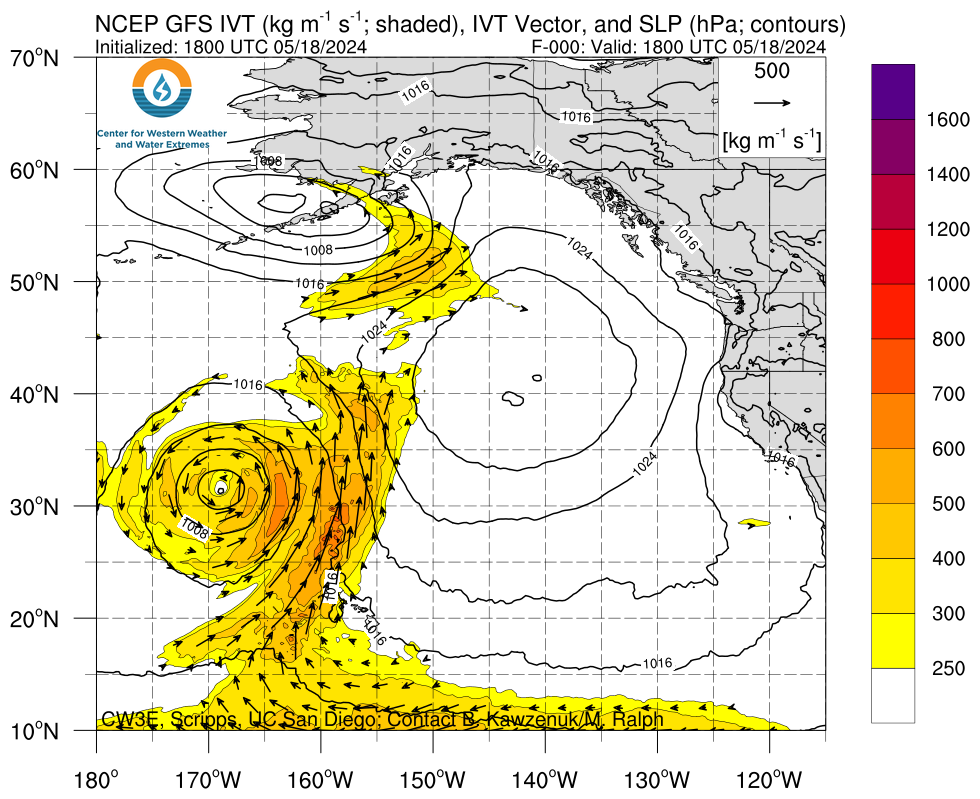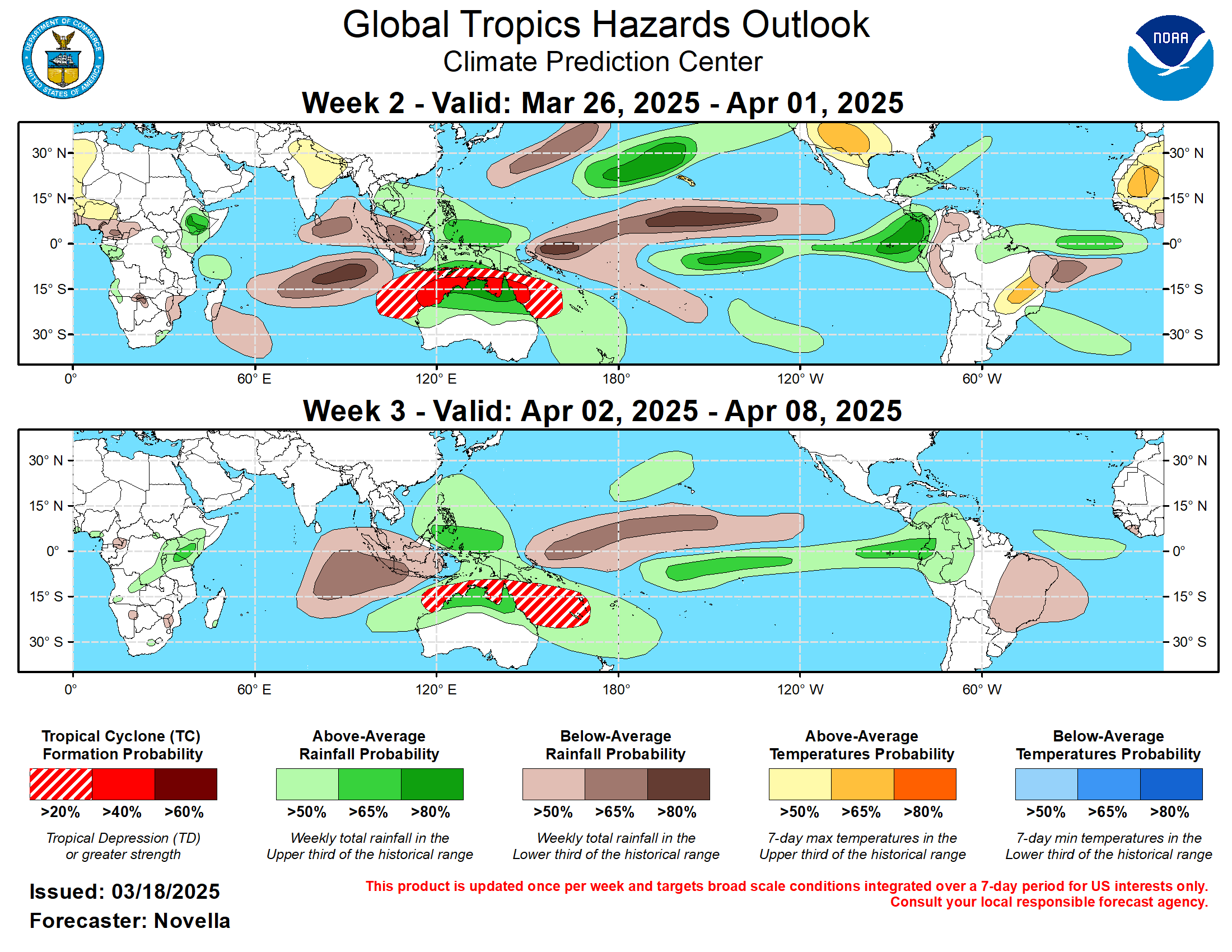This article focuses on what we are paying attention to in the next 48 to 72 hours. The article also includes weather maps for longer-term U.S. outlooks and a six-day World weather outlook which can be very useful for travelers.
First the NWS Short Range Forecast. The afternoon NWS text update can be found here after about 4 p.m. New York time but it is unlikely to have changed very much from the morning update. The images in this article automatically update.
Short Range Forecast Discussion
NWS Weather Prediction Center College Park MD
Tue Jun 18 2024
Valid 12Z Tue Jun 18 2024 – 12Z Thu Jun 20 2024…Significant heavy rain/flash flooding threat with gusty winds well
ahead of Potential T.C. One expected to impact southern Texas on
Wednesday...…More rounds of heavy rain and severe thunderstorms expected for the
northern Plains and upper Midwest today before shifting south into the
central Plains on Wednesday……A heat wave will persist over the Great Lakes, Ohio Valley and the
Northeast through midweek……Late-season wet snow continues across the high-elevations of the
northern Rockies today before tapering off early on Wednesday…An active weather pattern continues across the U.S. mainland. This
weather pattern that features snow, heat, heavy rain, severe
thunderstorms, strong winds, and fire weather is now bringing Potential
Tropical Cyclone One in the midst. A low pressure system currently
intensifying along a frontal boundary is fostering another round of heavy
rain and severe thunderstorms across the northern Plains into the upper
Midwest early this morning. The potent upper trough and the associated
dome of cold air have continued to result in a round of late-season wet
snow across the higher-elevations of the northern Rockies together with
rather strong wind gusts. With less potent jet stream energy behind this
system, the low pressure system will quickly eject into southern Canada by
this evening, bringing the inclement weather across the northern Plains to
an end by Wednesday morning. However, a sharp front trailing south and
southwest from the low center will likely trigger an axis of heavy rain
and severe thunderstorms from the central Plains to the upper Midwest by
tonight into Wednesday morning. From Wednesday into Thursday morning, the
rain/storms should gradually become more scattered in nature across the
central Plains as a cool high pressure system passes to the north. This
high pressure system will also push the widely scattered showers and
embedded thunderstorms farther east into the lower Great Lakes and
interior New England through Thursday morning.In stark contrast to the cool, windy, rainy and even snowy weather in the
West, a heat wave will settle and persist across the Great Lakes, Ohio
Valley and the Northeast through the next few days. Forecast highs today
and Wednesday will reach into the mid- to upper 90s, even the century mark
Wednesday and Thursday afternoon at the hottest locations in interior
northern New England. Widespread, numerous record-tying/breaking high
temperatures are possible. Additionally, morning lows will remain in
about the mid-70s, at record-tying/breaking levels, providing little
relief from the heat overnight. The early arrival of this magnitude of
heat, the duration, abundant sunshine, and lack of relief overnight will
increase the danger of this heatwave beyond what the exact temperature
values would suggest. This is especially true for those without adequate
air conditioning, which becomes more of a concern for locations further
north that are not as accustomed to periods of persistent heat.Another big weather story over the next couple of days will be in the Gulf
of Mexico where the National Hurricane Center has already initiated
advisories on Potential Tropical Cyclone One. An elongated upper trough
digging into the southern Plains and northeastern Mexico has already drawn
a plume of tropical moisture northward into the central Gulf Coast region.
This upper trough will be instrumental in drawing the tropical moisture
well north of the center of PTC One into southern Texas mainly on
Wednesday as PTC One tracks west toward northern Mexico. An axis of very
heavy rain may develop just inland of the Texas coastline behind a coastal
front with dynamic support from the elongated upper trough. This pattern
could result in locally heavy rainfall in excess of 10 inches near or just
inland of the lower to middle Texas coast which would result in
significant flash flooding. The heavy rain is forecast to push farther
inland across the Rio Grande Valley early on Thursday. In addition to the
heavy rainfall, some coastal flooding along with tropical-storm-force
winds can be expected up the Texas coast on Wednesday. See the latest
advisory from the National Hurricane Center for additional detailed
updates. Meanwhile, fire danger across the Four Corners region should
gradually ease over the next few days with the arrival of slightly cooler
air followed by the arrival of moisture from the northern edge of
Potential Tropical Cyclone One.
To get your local forecast plus active alerts and warnings click HERE and enter your city, state or zip code.
Learn about wave patterns HERE.
Then, looking at the world and of course, the U.S. shows here also. Today we are looking at precipitation.
Please click on “Read More” below to access the full Daily Report issued today.
| Notices: What would you like to learn about? Please provide that to me via the comment section at the end of the article. |
Now more detail on the 48-Hour Forecast (It is a 48 to 72 Hour Forecast actually)
Daily weather maps. The Day 1 map updates twice a day and the Day 2 and 3 maps update only once a day. These maps update automatically. But if that does not happen, you can get updates by clicking HERE
TODAY (or late in the day the evening/overnight map will appear) (Key to surface fronts shown on maps and you will then also be able to insert a city name or zip code and get a local NWS forecast).
TOMORROW
NEXT DAY
We have a new animation of the forecast which shows how things may play out over the next 60 hours. To update click ANIMATION. Doing so will get you to the dashboard. You can then step through the animation or hit LOOP on the upper right of the display. You will have to hit the back arrow ← at the top left on your computer to get back into this article. It is a little more trouble than before but I think NOAA scrapped the animation routine I was using so we have to keep up with “progress”.
The NWS Climate Prediction Center’s: Watches, Warnings, and Advisories plus other information can be found HERE. That takes you to the NWC Severe Weather Site. From there you can select among many categories of information. Remember to hit the back arrow ← at the top left of your screen to return to this article.
ATMOSPHERIC RIVERS
This tells us what is approaching the West Coast. Click HERE to update If I have not gotten around to doing the update. Here is some useful information about Atmospheric Rivers.
Below is the current five-day cumulative forecast of precipitation (Updates can be found HERE)
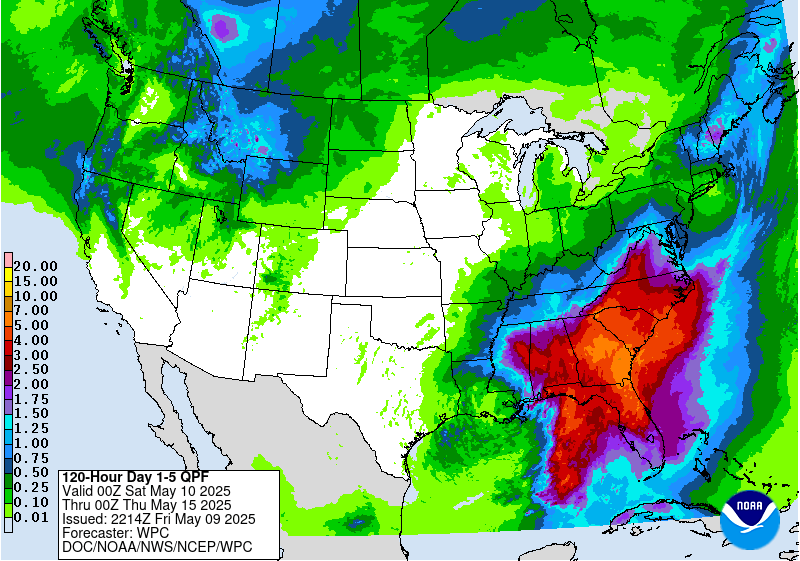
Ski SnowReports will Resume in the Fall.
Now we look at Intermediate-Term “Outlook” maps for three time periods. Days 6 – 10, Days 8 – 14, and Weeks 3 and 4. An outlook differs from a forecast based on how NOAA uses these terms in that an “outlook” presents information as deviation from normal and the likelihood of these deviations.
Below are the links to obtain updates and additional information. They are particularly useful if you happen to be reading this article significantly later than when it was published. I always try to provide readers with the source of the information in my articles. These links may also be useful for those viewing this article on a cell phone or other small screen.
| Days 6 – 10 (shown in Row 1) | Days 8 – 14 (Shown in Row 2) | Weeks 3 and 4 (Shown in Row 3 but updates only on Fridays) |
| https://www.cpc.ncep.noaa. gov/products/predictions/610day/ | https://www.cpc.ncep .noaa.gov/products/predictions/814day/ | https://www.cpc.ncep.noaa.gov/products/predictions/WK34/ |
Showing the actual maps. They should now update automatically. The Week 3 – 4 Outlook only updates on Fridays. So below is what I call the Intermediate-term outlook. On Fridays, it extends out 28 Days. That declines day by day so on Thursday it only looks out 22 days until the next day when the Week 3 – 4 Outlook is updated and this extends the outlook by one additional week.
| 6–
10
|
|
|
| 8–
14 |
|
|
| 3–
4 |
|
|
HAZARDS OUTLOOKS
Click here for the latest complete Day 3 -7 Hazards forecast which updates only on weekdays. Once a week probably Monday or Tuesday I will update the images. I provided the link for readers to get daily updates on weekdays. Use your own judgment to decide if you need to update these images. I update almost all the images Friday Night for the weekend edition of this Weather Report. So normally readers do not need to update these images but if the weather is changing quickly you may want to.
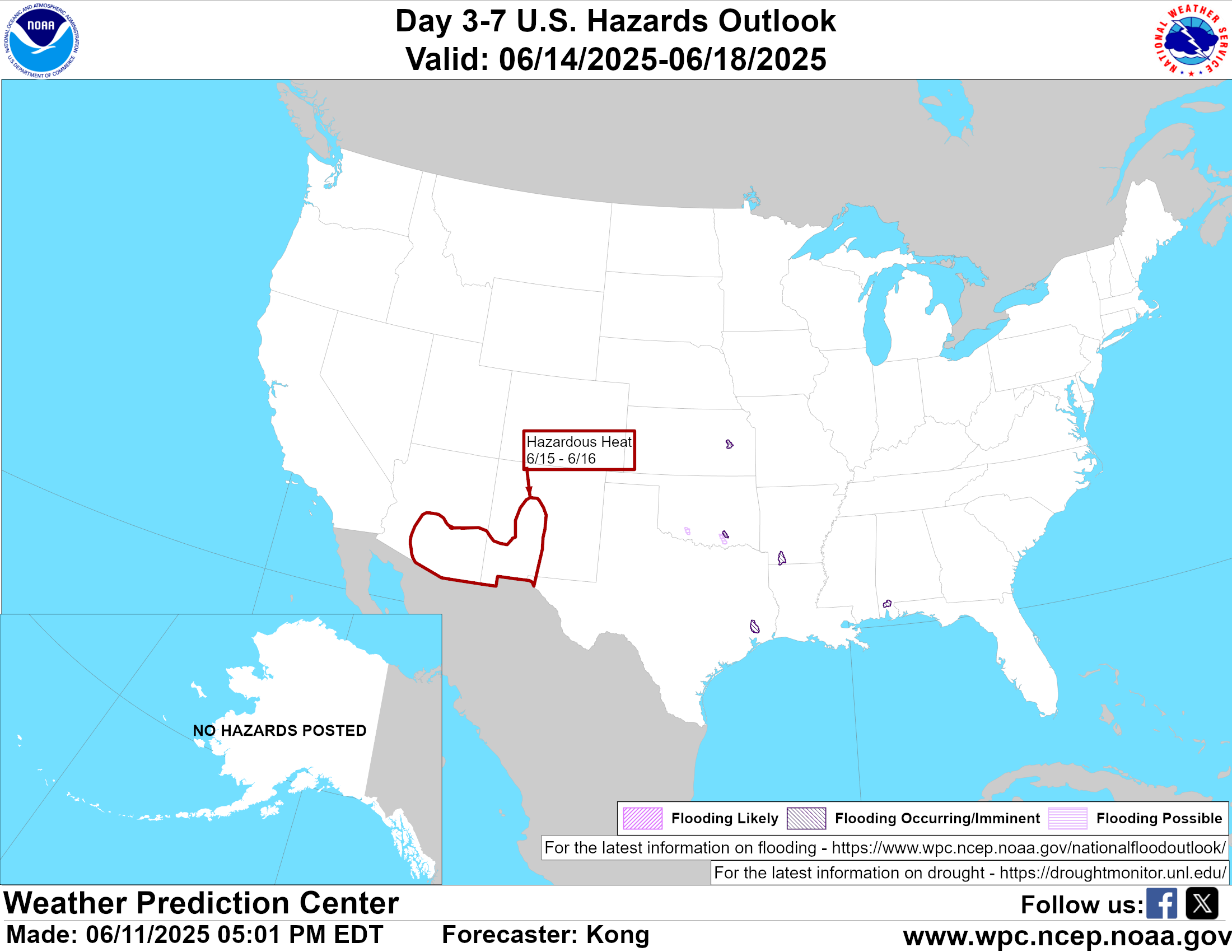
Temperature month to date can be found at https://hprcc.unl.edu/products/maps/acis/MonthTDeptUS.png
Precipitation month to date can be found at https://hprcc.unl.edu/products/maps/acis /MonthPNormUS.png
World Forecast [that website is has been intermittent so be patient]
Below are the Day 1 -3 and 4-6 forecasts for temperature and precipitation. Updates and much additional information can be obtained HERE
World Temperature Anomalies

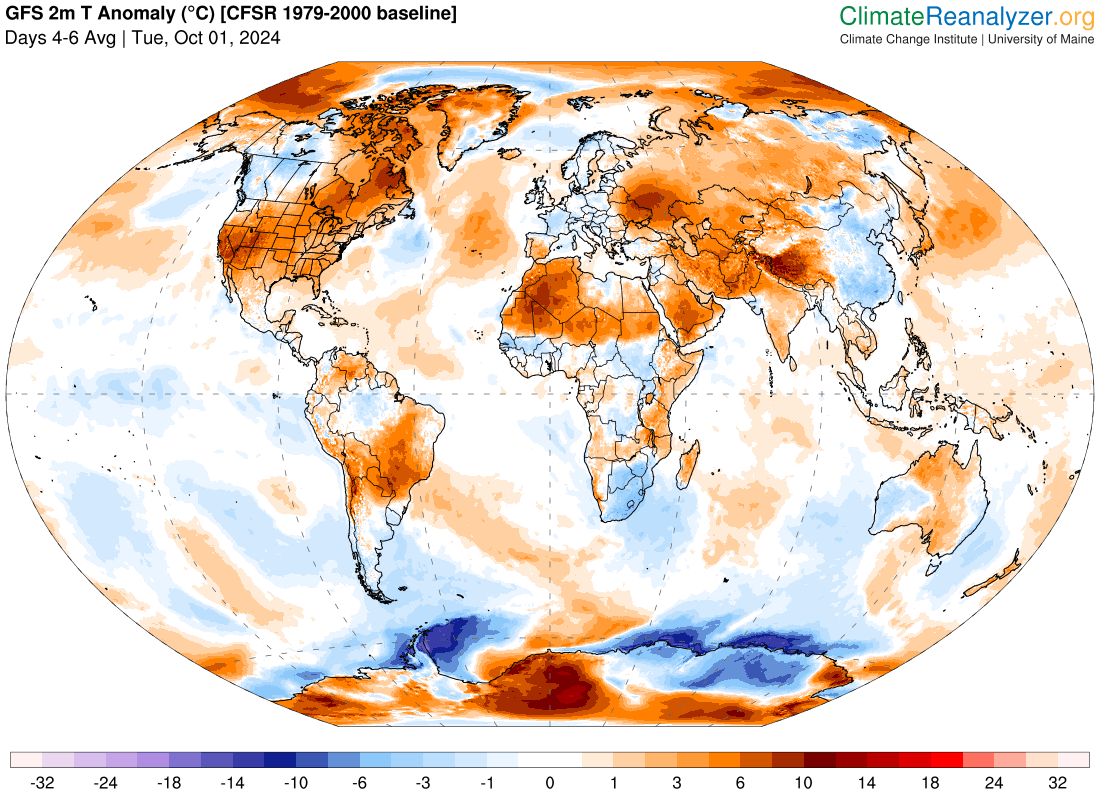
World Accumulated Precipitation
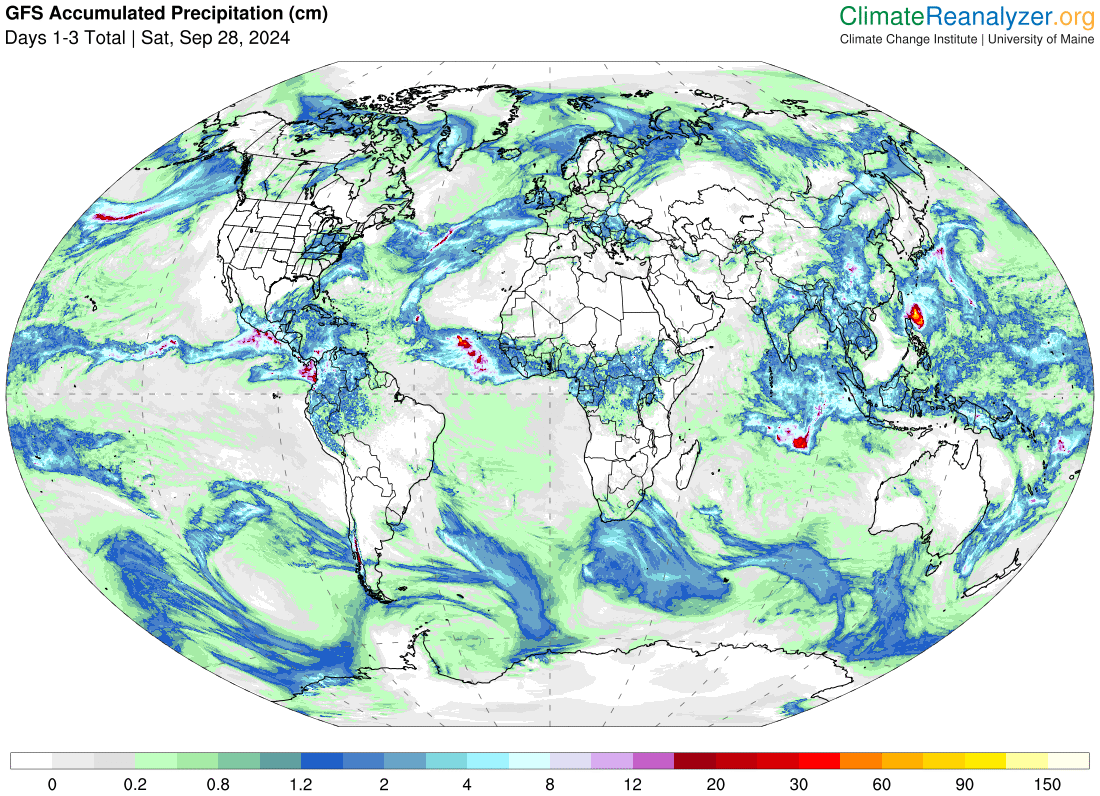

This information is provided by the University of Maine. They draw upon many different sources. There is a lot of information available at the link provided. I have just provided two useful forecasts. There are probably over a hundred different forecasts available from this source.
Worldwide Tropical Forecast (This is a NOAA Product)
This graphic updates on Tuesdays) If it has not been updated, you can get the update by clicking here Readers will only have to do that if they are reading this article much later than the date of it being published.
Information on Tropical Storms can be found HERE. Western Pacific information can be found HERE. Note that unless there is an out-of-season storm the below images will not update until the National Hurricane Center starts their seasonal update of these maps on June 1. I include them simply because there can be an out-of-season event in which case it should show up in these maps.


–
| I hope you found this article interesting and useful. |
–

